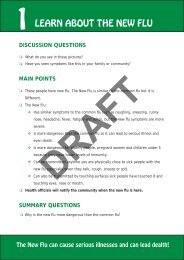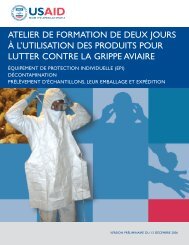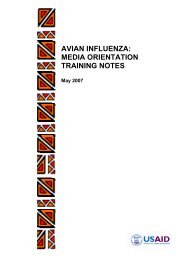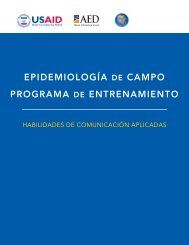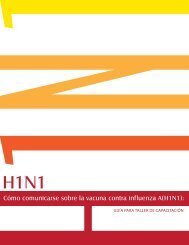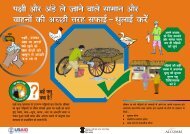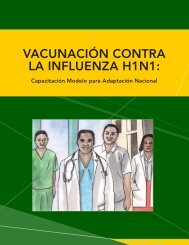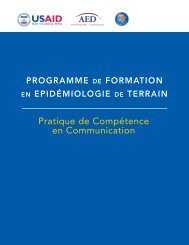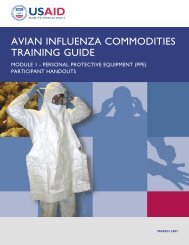AI.COMM - Avian and Pandemic Influenza Resource Link
AI.COMM - Avian and Pandemic Influenza Resource Link
AI.COMM - Avian and Pandemic Influenza Resource Link
Create successful ePaper yourself
Turn your PDF publications into a flip-book with our unique Google optimized e-Paper software.
These messages were adjusted over the life of the project based on continuous streams<br />
of data from research, monitoring <strong>and</strong> evaluation activities, as well as the evolving<br />
epidemiological fi ndings. Since those initial KAP studies in Southeast Asia, <strong>AI</strong>.<strong>COMM</strong> has<br />
conducted over 50 qualitative <strong>and</strong> quantitative research activities in more than 25 countries.<br />
In addition to KAP surveys, the project also has employed Values <strong>and</strong> Lifestyles instruments,<br />
pre-testing surveys, focus group discussions, participatory action research (PAR), <strong>and</strong><br />
supply chain analyses. The research has transcended the country level <strong>and</strong> has examined<br />
regional dynamics such as those in the Gangetic Plain of India, Nepal, Bangladesh <strong>and</strong><br />
in the Greater Mekong Region. Some of these studies were documented in a 30-page<br />
booklet designed by <strong>AI</strong>.<strong>COMM</strong> called Making the Magic: Turning Research Findings into<br />
Memorable Communications.<br />
Qualitative research – which<br />
usually focuses on the whys <strong>and</strong><br />
hows of decision making rather<br />
than the what, where <strong>and</strong> when<br />
of quantitative evaluations – were<br />
undertaken to help identify the<br />
barriers that prevent target<br />
audiences from adopting the<br />
behaviors that prevent the spread<br />
of H5N1 as well as the beliefs<br />
<strong>and</strong> values of target audiences,<br />
including backyard (rural <strong>and</strong><br />
urban dense) small poultry<br />
farmers; supply chain actors in<br />
the poultry industry including<br />
market vendors, middlemen,<br />
transporters, <strong>and</strong> suppliers; <strong>and</strong><br />
national <strong>and</strong> district government<br />
stakeholders (e.g., local government<br />
offi cials, private <strong>and</strong> commercial<br />
sector poultry producers, animal<br />
<strong>and</strong> human health care providers,<br />
<strong>and</strong> offi cials <strong>and</strong> leaders in<br />
civil society). Reports on some<br />
of this qualitative research can be<br />
found at www.avianfl u.aed.org/<br />
research.htm<br />
<strong>AI</strong>.<strong>COMM</strong> also participated in an omnibus<br />
survey in six countries in South <strong>and</strong> Southeast<br />
Asia that provides a snapshot glimpse into levels<br />
of recognition <strong>and</strong> awareness among general<br />
populations <strong>and</strong> target audiences related<br />
to p<strong>and</strong>emic <strong>and</strong> avian infl uenza. The omnibus<br />
survey used predominantly face-to-face interviews<br />
to gather the information in the<br />
Philippines, Indonesia, Vietnam, Thail<strong>and</strong>,<br />
Bangladesh <strong>and</strong> India, <strong>and</strong> included questions<br />
for the general public on their awareness <strong>and</strong><br />
ability to take precautions related to avian<br />
<strong>and</strong> p<strong>and</strong>emic infl uenza. An additional set<br />
of questions was targeted to urban <strong>and</strong><br />
peri-urban poultry farmers to gauge their<br />
awareness of practices that can limit the<br />
spread of the virus, <strong>and</strong> surveys in Vietnam<br />
<strong>and</strong> the Philippines also inquired specifi cally<br />
about avian fl u-related communication activities.<br />
19



